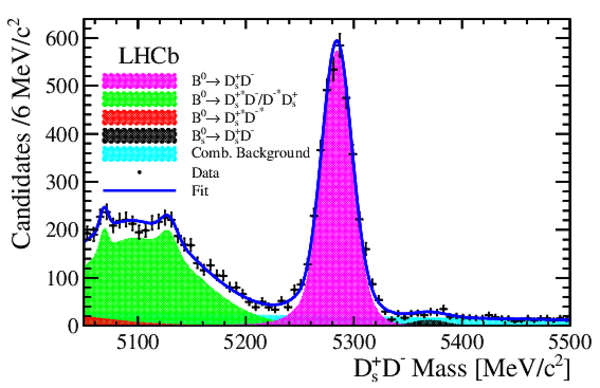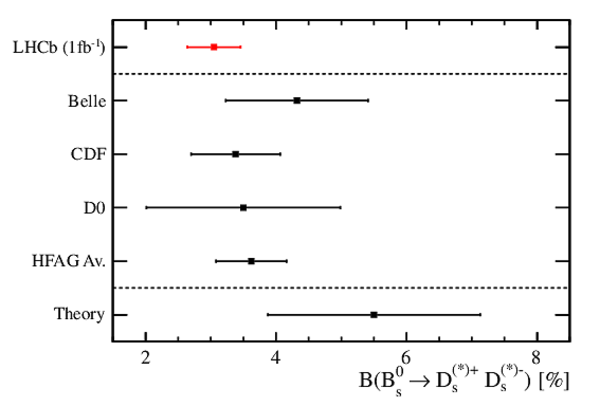Measurement of the $B_{s}^{0} \rightarrow D_{s}^{(*)+}D_{s}^{(*)-}$ branching fractions
[to restricted-access page]Information
LHCb-PAPER-2015-053
CERN-EP-2016-028
arXiv:1602.07543 [PDF]
(Submitted on 24 Feb 2016)
Phys. Rev. D93 (2016) 092008
Inspire 1423299
Tools
Abstract
The branching fraction of the decay $B_{s}^{0} \rightarrow D_{s}^{(*)+}D_{s}^{(*)-}$ is measured using $pp$ collision data corresponding to an integrated luminosity of $1.0fb^{-1}$, collected using the LHCb detector at a centre-of-mass energy of $7$TeV. It is found to be \begin{align*} {\mathcal{B}}(B_{s}^{0}\rightarrow D_{s}^{(*)+}D_{s}^{(*)-}) = (3.05 \pm 0.10 \pm 0.20 \pm 0.34)\%, \end{align*} where the uncertainties are statistical, systematic, and due to the normalisation channel, respectively. The branching fractions of the individual decays corresponding to the presence of one or two $D^{*\pm}_{s}$ are also measured. The individual branching fractions are found to be \begin{align*} {\mathcal{B}}(B_{s}^{0}\rightarrow D_{s}^{*\pm}D_{s}^{\mp}) = (1.35 \pm 0.06 \pm 0.09 \pm 0.15)\%, \newline{\mathcal{B}}(B_{s}^{0}\rightarrow D_{s}^{*+}D_{s}^{*-}) = (1.27 \pm 0.08 \pm 0.10 \pm 0.14)\%. \end{align*} All three results are the most precise determinations to date.
Figures and captions
|
Invariant mass distribution of the $ B ^0_ s \rightarrow D ^{(*)+}_ s D ^{(*)-}_ s $ candidates. Also shown is the fit function and the individual components of the fit model. |
Fig1.pdf [43 KiB] HiDef png [845 KiB] Thumbnail [341 KiB] *.C file |

|
|
Invariant mass distribution of the $ { B ^0 \rightarrow D^{(*)\pm}_{s} D_{}^{(*)\mp}}$ candidates. Also shown is the fit function and the individual components of the fit model. |
Fig2.pdf [46 KiB] HiDef png [594 KiB] Thumbnail [291 KiB] *.C file |

|
|
The $ B ^0_ s \rightarrow D ^{(*)+}_ s D ^{(*)-}_ s $ branching fraction measurements by Belle , CDF , and D0 , the current world average, the theoretical prediction from Ref. [3], and the new LHCb result. |
Fig3.pdf [13 KiB] HiDef png [83 KiB] Thumbnail [82 KiB] *.C file |

|
|
Animated gif made out of all figures. |
PAPER-2015-053.gif Thumbnail |

|
Tables and captions
|
Efficiencies of the various selection criteria for the three individual channels of $ B ^0_ s \rightarrow D ^{(*)+}_ s D ^{(*)-}_ s $ , and for $ B ^0 \rightarrow D ^+_ s D ^- $. Each efficiency is presented relative to the previous cut and measured using simulated events, except for the PID efficiency which is obtained from data. The $ D ^+_ s $ veto was only applied to the normalisation mode, $ B ^0 \rightarrow D ^+_ s D ^- $. |
Table_1.pdf [54 KiB] HiDef png [101 KiB] Thumbnail [44 KiB] tex code |

|
|
Efficiency of the normalisation channel $ B ^0 \rightarrow D ^+_ s D ^- $ relative to the signal decays. |
Table_2.pdf [63 KiB] HiDef png [93 KiB] Thumbnail [41 KiB] tex code |

|
|
The yields extracted from the fit to the $ B ^0_ s \rightarrow D ^{(*)+}_ s D ^{(*)-}_ s $ candidate sample. |
Table_3.pdf [52 KiB] HiDef png [90 KiB] Thumbnail [42 KiB] tex code |

|
|
The yields extracted from the fit to the $ { B ^0 \rightarrow D^{(*)\pm}_{s} D_{}^{(*)\mp}}$ candidate sample. |
Table_4.pdf [52 KiB] HiDef png [89 KiB] Thumbnail [40 KiB] tex code |

|
|
Systematic uncertainties, in % of the relevant branching fraction ratio, for the $ B ^0_ s \rightarrow D ^{(*)+}_ s D ^{(*)-}_ s $ branching fraction ratios. |
Table_5.pdf [77 KiB] HiDef png [52 KiB] Thumbnail [24 KiB] tex code |

|
Created on 02 May 2024.
